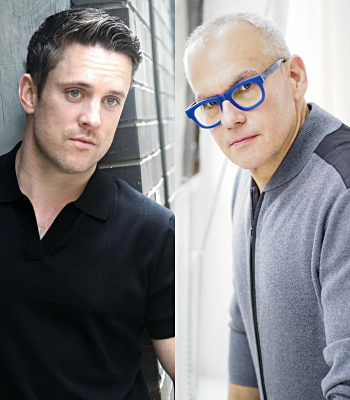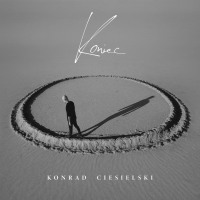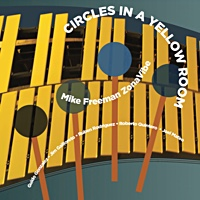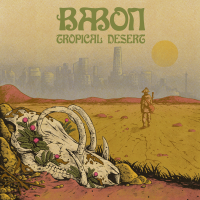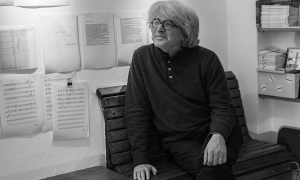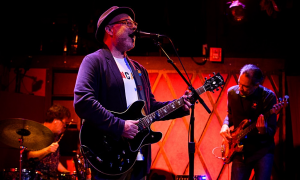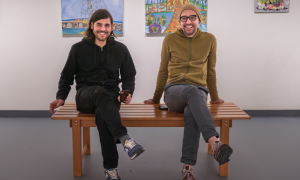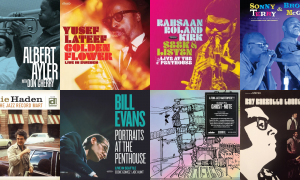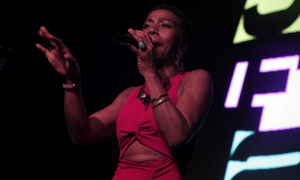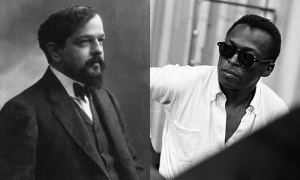Home » Jazz Articles » Interview » Eugene Chadbourne: Beauty Out of Chaos
Eugene Chadbourne: Beauty Out of Chaos
Beautiful melodies and harmonies come about as the result of chance procedures just as often as chaos does.
 Over more than thirty years of a seemingly endless variety of recordings and playing situations, Eugene Chadbourne has made himself into about as eclectic a performer as you could ask for. In addition to his own composing and improvising, he's devoted entire albums to the music of such artists as Albert Ayler, J.S. Bach, Jimi Hendrix and Phil Ochs, and has worked with Derek Baily, Han Bennink, Frank Lowe, and John Zorn, to name but a few. His devotion to many other musicians and many different genres has led to some brilliantly unpredictable hybrids. If it's still possible to be shocked by what he's up to, his duo with saxophonist Oliver Lake this month may be yet another surprise by the ever inventive Dr. Chadbourne.
Over more than thirty years of a seemingly endless variety of recordings and playing situations, Eugene Chadbourne has made himself into about as eclectic a performer as you could ask for. In addition to his own composing and improvising, he's devoted entire albums to the music of such artists as Albert Ayler, J.S. Bach, Jimi Hendrix and Phil Ochs, and has worked with Derek Baily, Han Bennink, Frank Lowe, and John Zorn, to name but a few. His devotion to many other musicians and many different genres has led to some brilliantly unpredictable hybrids. If it's still possible to be shocked by what he's up to, his duo with saxophonist Oliver Lake this month may be yet another surprise by the ever inventive Dr. Chadbourne.All About Jazz: I was surprised when you told me about your duo with Oliver Lake this month, but you guys have played together before. When was that, and how did it come about?
Eugene Chadbourne: When I first started playing professionally I was around Oliver Lake a fair bit. He was playing with Leo Smith's band at that point as well as doing a lot of other stuff. I brought them all into the arts center in Calgary and arranged a solo gig for Oliver. I recorded his tune "Rocket! on my second solo record and it was the first time anyone recorded one of his pieces other than himself. I saw him play in a lot of contexts in NYC and at one point he had me play as a guest with Jump Up at the Public Theater.
I have basically always been really impressed by everything the guy is up to. Recently I brought him together with various young players in an international group, the kind of gig where ideally you are getting together to enjoy playing jazz, in this case Eric Dolphy and Oliver Lake tunes. I was really blown away by how much energy and spirit he brought to this endeavor, from the first solo he played in the rehearsal he was just completely on the case.
AAJ: You cover a lot of ground. Besides being a great improviser, your work at times references country, movie soundtracks, decades of rock—including heavy metal—and jazz. Sometimes it's clearly meant to complement the person you're playing with, as when you work with people who have played with Frank Zappa or Gil Scott-Heron. How do you see the function of referencing, or even covering, other people's work in your music?
EC: Well, obviously I do it, I don't see it in any way other than just part of the job I do.
AAJ: Do you have divisions in your head about when you're playing jazz or rock or country and when you're just playing Chadbourne?
EC: Not exactly divisions. Stylistically there are different ways of playing; then again they can cross over. Many original tunes of mine are set in styles based partially at least on other people.
AAJ: You've recorded a lot of material by musicians very much in the jazz tradition. I'd like to ask you to reflect on some of them, how you chose to do their material and what they mean to you.
The obvious starting point, I think, is Albert Ayler. You recorded a full album of his compositions, with Joe Williamson and Uli Jenessen [Ayler Undead (Grob 2001)], and in the notes reference a critic who said you do for Ayler what Steve Lacy did for Monk. Pretty high praise! How did that project come about?
The producer suggested it, based on my background with Ayler. The recording process wound up more like Shockabilly [Chadbourne's wild and wooly '80s group with Kramer and David Licht], I had to redo the electric guitar parts because the PA guy took me out of the mix, I was playing so loud!
AAJ: Your history of playing Monk goes back at least to 1984, when Shockabilly played on the Hal Wilner tribute record That's the Way I Feel. Monk's sinewy themes seem so suited to piano—what is it like to translate them to guitar or banjo?
EC: I played Monk from the moment I played jazz, well before Shockabilly. In fact the Wilner thing you mention was a bit dicey because he wanted me to play Monk on it yet that was not at all the type of music Shockabilly played, there was not a single jazz cover in our set lists. Kramer had no feel for jazz or Monk whatsoever. Personally I think that track is horrifying. It is true what you say about the piano, it is similar to Charlie Parker's music being suited to the saxophone. It is really difficult finding ways to play Monk on other instruments, yet in the end it will work, look at the beautiful solo sax versions by Steve Lacy.
It is true what you say about the piano, it is similar to Charlie Parker's music being suited to the saxophone. It is really difficult finding ways to play Monk on other instruments, yet in the end it will work, look at the beautiful solo sax versions by Steve Lacy.
AAJ: Total Tuesday, originally released on Ponk and now available through your own Chadula, remains one of my favorite records of yours. The group, Hellington Country, included Paul Lovens and Alex Ward, who should be well-known to anyone following Euro improv. You created the compositions by cutting up sheet music of pieces by Duke Ellington and Hank Williams and taping them together in different arrangements. That could be taken as a hard copy realization of the way you approach music. Can you talk a little about that band, and about making a Duke Frankenstein?
EC: Actually, Kurt—Frankenstein is the doctor, not the monster. And the monster was not put together randomly, at least not in most versions of the story. The random aspect is important because despite the implied chaos, beautiful melodies and harmonies come about as the result of chance procedures just as often as chaos does.
AAJ: You've also recorded songs by Rahsaan Roland Kirk and Charles Mingus, and it seems you've intentionally chosen their political songs, like "Volunteered Slavery and "Fables of Faubus. You've done a lot of protest music, your own and other peoples'. Any comment on Mingus and Kirk and their place in history?
EC: No I hardly think a comment on these guys is necessary in a jazz magazine. I do like to study all the political jazz music from that period, also Gary Bartz Ntu Troop whose material we started nibbling on in GOIN. [The Get Out of Iraq Now band, with Victor Delorenzo and Brian Ritchie of the Violent Femmes and Brian Jackson, who played with Gil Scott-Heron.]
AAJ: One of your closer playing relationships also pits you right in a fascinating bit of jazz history. Han Bennink played on Eric Dolphy's last record when he was just twenty-three. You and Bennink have been playing together for years, and even put the song "Miss Ann, from that Dolphy record, out on a 7 . The two of you seem remarkably well-suited to each other. What do you think makes the duo work? EC:That duo has worked through a changing set of circumstances, it worked when I was just a greenhorn and Han was doing much more of a surrealistic performance with multi-instruments, etc, it still works decades later with him settling down to the drum set and no longer demolishing the country songs I throw in halfway through. Over the years he has gotten into a lot of the rock music I play, which he skipped the first time around when it was new: "Hey, I like Captain Beefheart," he told me at one point a few years ago.
EC:That duo has worked through a changing set of circumstances, it worked when I was just a greenhorn and Han was doing much more of a surrealistic performance with multi-instruments, etc, it still works decades later with him settling down to the drum set and no longer demolishing the country songs I throw in halfway through. Over the years he has gotten into a lot of the rock music I play, which he skipped the first time around when it was new: "Hey, I like Captain Beefheart," he told me at one point a few years ago.
AAJ: Lastly, you've become a pretty prolific contributor to the All Music Guide web site, writing bios and reviews of many other musicians. Are you learning as much as you're teaching with that gig?
EC: The research is probably more valuable to me than it is to them in the end. Several different projects I have going on gain invaluable information as a result of the biographies and discographies I have been working on. Mainly, though, it is a way to give young or unknown people a little boost, at least some of them tell me the reviews and write-ups help.
Selected Discography
Eugene Chadbourne, The Hills Have Jazz (Boxholder, 2003)
Eugene Chadbourne/Joe Williamson/Uli Jenessen, Ayler Undead (Grob, 2001)
Eugene Chadbourne, Beauty and the Bloodsucker (Leo, 1997-99)
Eugene Chadbourne, Strings (Intakt, 1992)
Han Bennink/Eugene Chadbourne/Toshinori Kondo, Jazz Bunker (Golden Years of Jazz, 1980)
Eugene Chadbourne, Boogie with the Hook (with Charles Tyler) (Leo, 1977)
Photo Credits
Top Photo: Courtesy of Eugene Chadbourne
Bottom Photo: Juan-Carlos Hernández
Tags
PREVIOUS / NEXT
Support All About Jazz
 All About Jazz has been a pillar of jazz since 1995, championing it as an art form and, more importantly, supporting the musicians who make it. Our enduring commitment has made "AAJ" one of the most culturally important websites of its kind, read by hundreds of thousands of fans, musicians and industry figures every month.
All About Jazz has been a pillar of jazz since 1995, championing it as an art form and, more importantly, supporting the musicians who make it. Our enduring commitment has made "AAJ" one of the most culturally important websites of its kind, read by hundreds of thousands of fans, musicians and industry figures every month.






